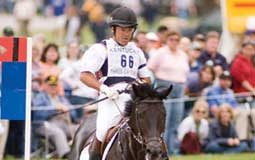
California Chrome has worn a FLAIR Strip during every race of his undefeated career. Photo by Z.
(What kind of bit is he wearing?)
Essentially, these adhesive strips work the same way that anti-snoring strips work on humans. They are worn over the soft tissue above the horse’s nostrils to prevent constriction of the nasal passages during exercise, which reduces air intake and could negatively impact performance. Unlike humans or dogs that pant during intense exercise, horses only breathe through their noses. The added intake capacity has the potential to reduce the risk of injury to the lungs, especially during prolonged exercise.
Of all the controversial aspects of modern horse racing, nasal strips seem relatively innocuous. Compared with medication or surgical solutions, the strips are non-invasive and have no side effects. Nevertheless, New York’s State Gaming Commission had a rule that stated that equipment used during a race must be specifically approved by the stewards. New York is the only state with a rule that affects the use of nasal strips.
Chrome’s trainer, Art Sherman, requested special permission to use nasal strips during the Belmont Stakes. On Monday, May 19, 2014, the New York State Gaming Commision and New York Racing Association announced that the stewards had agreed to allow the use of nasal strips for all horses.
In 2012, Triple Crown hopeful I’ll Have Another won the first two races wearing nasal strips and was told that he would not be able to wear them in the Belmont. He was ultimately scratched from the race and retired to stud due to a tendon injury.

Nasal strips are a common sight in the cross-country phase of three-day evenitng. Here, Hawley Bennett-Awad rides Gin and Juice at the 2014 Rolex Kentucky Three-Day Event. Photo: Leslie Potter
FLAIR Strips, the most common equine brand, were introduced to the market at the turn of the 21st century, first at the 1999 Breeder’s Cup races and then at the 2000 Olympics. They are often used for eventers during the cross-country phase, polo ponies, and sometimes western performance horses in speed events.
Nasal strips are approved for use by most major equine associations, including the United States Equestrian Federation, the Fédération Equestre Internationale, the American Quarter Horse Association and the National Barrel Horse Association.






This is a very good informative article which explains what these nasal strips are & how they work, to the general public. I’m very happy the NYRA had a change of heart regarding these strips. They supposedly already approved them for harness racing Standardbreds, but not for Thoroughbreds, which was an unfair double standard. They are gaining popularity in the horse world as a non invasive protective breathing aid, not too different than wrapping a horse’s legs before performing or training to support & protect them.
I see no reason why horses can’t use nasal strips. It’s not a drug
Valerie makes some good points. I think NY should get rid of its ban altogether. The strips don’t harm the horse, and I don’t think they are an unfair advantage. Why do they let horses race on Lasix but not wear nasal strips?
I have a horse that would benefit from a nasal strip….no she does not snore. but has a lung issue as a baby, and as soon as it gets cold, you can hear her breathing.
I know they use these in cross country sometimes right! Thats something i will have to remember! I never realized that nasal strips could be controversial
Glad the New York Racing group is allowing California Chrome to use the nasal strip when he runs in Belmont. I would love to see Triple Crown winner once again.
It’s harmless, and if everyone has the option to use a nasal strip, there is no unfair advantage.
Thank you for clarifying.
They shouldn’t be banned. There are no chemical’s in them. They tie some horse’s tongue’s when they race.
Why can’t they use the strips.
Really very thrilling experience to see it live. Of course very much interesting to watch such races. I would never want to miss these. Thanks for sharing it here. Any news related to horses is my all time favorite. Great read.
The horse on the left looks completely stressed out and unhappy. Is that his tongue hanging out? Racing is not “fun” for horses. Ban horse racing altogether and forget about breathing strips. A retired race horse in my barn blew food out of his nose because of an operation to “open” his breathing passages so he could race faster. Was it worth it? Apparently someone thought so.
Interesting.